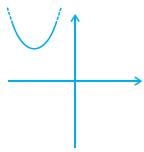NCERT Exemplar: Polynomials - 1 | Mathematics (Maths) Class 10 PDF Download
Exercise 2.1
Choose the correct answer from the given four options in the following questions:
Q.1. If one of the zeroes of the quadratic polynomial (k–1) x2 + k x + 1 is –3, then the value of k is
(a) 4/3
(b) -4/3
(c) 2/3
(d) -2/3
Correct Answer is Option (a)
According to the question,
-3 is one of the zeros of quadratic polynomial (k-1)x2+kx+1
Substituting -3 in the given polynomial,
(k - 1)(-3)² + k(-3) + 1 = 0
(k - 1)9 + k(-3) + 1 = 0
9k - 9 -3k + 1 = 0
6k - 8 = 0
k = 8/6
Therefore, k =4 /3
Hence, option (A) is the correct answer.
Q.2. A quadratic polynomial, whose zeroes are –3 and 4, is
(a) x2 – x + 12
(b) x2 + x + 12
(c) (x2/2) - (x/2) - 6
(d) 2x2 + 2x –24
Correct Answer is Option (c)
Sum of zeroes, α+ β= -3+4 =1
Product of Zeroes, αβ = -3× 4 = -12
Therefore, the quadratic polynomial becomes,
x²- (sum of zeroes)x+(product of zeroes)
= x²- (α+ β)x+(αβ)
= x² – (1)x + (-12)
= x² – x -12
divide by 2, we get
= x²/2 – x/2 - 12/2
= x²/2 – x/2 -6
Hence, option (c) is the correct answer.
Q.3. If the zeroes of the quadratic polynomial x2 + (a + 1) x + b are 2 and –3, then
(a) a = –7, b = –1
(b) a = 5, b = –1
(c) a = 2, b = – 6
(d) a = 0, b = – 6
Correct Answer is Option (d)
According to the question,
x² + (a + 1)x + b
Given that, the zeroes of the polynomial = 2 and -3,
When x = 2
2² + (a + 1)(2) + b = 0
4 + 2a + 2 + b = 0
6 + 2a + b = 0
2a + b = -6 . ....... (1)
When x = -3,
(-3)² + (a + 1)(-3) + b = 0
9 – 3a - 3 + b = 0
6 – 3a + b = 0
-3a + b = -6 ....... (2)
Subtracting equation (2) from (1)
2a + b – (-3a + b) = -6-(-6)
2a + b + 3a - b = -6 + 6
5a = 0
a = 0
Substituting the value of ‘a’ in equation (1), we get,
2a + b = -6
2(0) +b = -6
b = -6
Hence, option (d) is the correct answer.
Q.4. The number of polynomials having zeroes as –2 and 5 is
(a) 1
(b) 2
(c) 3
(d) more than 3
Correct Answer is Option (d)
According to the question,
The zeroes of the polynomials = -2 and 5
We know that the polynomial is of the form,
p(x) = ax2 + bx + c.
Sum of the zeroes = – (coefficient of x) ÷ coefficient of x2 i.e.
Sum of the zeroes = – b/a
– 2 + 5 = – b/a
3 = – b/a
b = – 3 and a = 1
Product of the zeroes = constant term ÷ coefficient of x2 i.e.
Product of zeroes = c/a
(- 2)5 = c/a
– 10 = c
Substituting the values of a, b and c in the polynomial p(x) = ax2 + bx + c.
We get, x2 – 3x – 10
Therefore, we can conclude that x can take any value.
Hence, option (d) is the correct answer.
Q.5. Given that one of the zeroes of the cubic polynomial ax3 + bx2 + cx + d is zero, the product of the other two zeroes is
(a) (–c/a)
(b c/a
(c) 0
(d) (–b/a)
Correct Answer is Option (b)
According to the question,
We have the polynomial,
ax3 + bx2 + cx + d
We know that,
Sum of product of roots of a cubic equation is given by c/a
It is given that one root = 0
Now, let the other roots be α, β
So, we get,
αβ + β(0) + (0)α = c/a
αβ = c/a
Hence the product of other two roots is c/a
Hence, option (b) is the correct answer
Q.6. If one of the zeroes of the cubic polynomial x3 + ax2 + bx + c is –1 then the product of the other two zeroes is
(a) b – a + 1
(b) b – a – 1
(c) a – b + 1
(d) a – b –1
Correct Answer is Option (a)
Let α, β be the other zeros of the given polynomial x3 + ax2 + bx2 + c
Again,=αβ=b+α+β
α+β=−a+1 , from (i))
=b−a+1
Q.7. The zeroes of the quadratic polynomial x2 + 99x + 127 are
(a) both positive
(b) both negative
(c) one positive and one negative
(d) both equal
Correct Answer is Option (b)
Given polynomial is x2 + 99x + 127
Sum of zeroes =−99
Product of zeroes =27
∵ Sum of zeroes is negative and product of zeroes is positive, this is only possible if both should be negative.
∴ Both zeros will be negative.
Q.8. The zeroes of the quadratic polynomial x2 + kx + k, k ≠ 0,
(a) cannot both be positive
(b) cannot both be negative
(c) are always unequal
(d) are always equal
Correct Answer is Option (a)
Given, the quadratic polynomial is x² + kx + k
We have to find the zeros of the polynomial
We know that, if α and β are the zeroes of a polynomial ax2 + bx + c, then
Sum of the roots is α + β = -b/a
Product of the roots is αβ = c/a
Where, a = coefficient of x² term
b = coefficient of x term
c = coefficient of constant term
Here, a = 1, b = k and c = k
Sum of the roots = -k/1
= -k
Product of the roots = k/1
= k
If k is negative,
Sum of the roots is positive
Product of the roots is negative.
So, one zero will be positive and other zero will be negative
If k is positive,
Sum of the roots is negative
Product of the roots is positive.
So, both the zeros will be negative.
Therefore, the zeros of the quadratic polynomial in both cases cannot be positive.
Q.9. If the zeroes of the quadratic polynomial ax2 + bx + c, c ≠ 0 are equal, then
(a) c and a have opposite signs
(b) c and b have opposite signs
(c) c and a have the same sign
(d) c and b have the same sign
Correct Answer is Option (c)
Given that the zeros of the quadratic polynomial ax2 + bx + c, c≠0 are equal.
⇒ Value of the discriminant(D) has to be zero.
⇒ b2 −4ac=0
⇒ b2 =4ac
Since. L.H.S b2 cannot be negative, thus, R.H.S. can also be never negative.
Therefore, a and c must be of the same sign.
Q.10. If one of the zeroes of a quadratic polynomial of the form x2+ax + b is the negative
of the other, then it
(a) has no linear term and the constant term is negative.
(b) has no linear term and the constant term is positive.
(c) can have a linear term but the constant term is negative.
(d) can have a linear term but the constant term is positive.
Correct Answer is Option (a)
Given, the quadratic polynomial is x² +ax + b.
One of the zeros of the polynomial is the negative of the other.
A quadratic polynomial in terms of the zeroes (α,β) is given by
x2 - (sum of the zeroes) x + (product of the zeroes)
i.e, f(x) = x2 -(α +β) x +αβ
Given, β = -α
So, sum of the zeros, α +β = α - α = 0
The coefficient of the x term will be zero.
Product of the roots, αβ = -α²
The constant term b will be negative.
Now, f(x) = x² - α²
Therefore, the quadratic polynomial has no linear term and the constant term is negative.
Q.11. Which of the following is not the graph of a quadratic polynomial?
(a) 
(b) 
(c) 
(d) 
Correct Answer is Option (d)
For any quadratic polynomial ax² + bx + c, where a ≠0 the graph of the corresponding equation y = ax² + bx + c has one of the two shapes either open upwards like U or open downwards like inverted U (i.e. ∩) depending on whether a > 0 or a < 0.In other words, the graph of a quadratic polynomial is a parabola.
A quadratic polynomial has less than or equal to two roots.
From the given options,
In Option D, the curve crosses the x-axis on three points.
This implies it has more than 3 roots, so it does not represent the quadratic polynomial.
Therefore, option D cannot be the graph of a quadratic polynomial.
Exercise 2.2
Q.1. Answer the following and justify:
(i) Can x2 – 1 be the quotient on division of x6 + 2x3 + x – 1 by a polynomial in x of degree 5?
No, x2 – 1 cannot be the quotient on division of x6 + 2x3 + x – 1 by a polynomial in x of degree 5.
Justification:
When a degree 6 polynomial is divided by degree 5 polynomial,
The quotient will be of degree 1.
Assume that (x2 – 1) divides the degree 6 polynomial with and the quotient obtained is degree 5 polynomial (1)
According to our assumption,
(degree 6 polynomial) = (x2 – 1)(degree 5 polynomial) + r(x) [ Since, (a = bq + r)]
= (degree 7 polynomial) + r(x) [ Since, (x2 term × x5 term = x7 term)]
= (degree 7 polynomial)
From the above equation, it is clear that, our assumption is contradicted.
x2 – 1 cannot be the quotient on division of x6 + 2x3 + x – 1 by a polynomial in x of degree 5
Hence Proved.
(ii) What will the quotient and remainder be on division of ax2 + bx + c by px3 + qx2 + rx + s, p ≠ 0?
Degree of the polynomial px3 + qx2 + rx + s is 3
Degree of the polynomial ax2 + bx + c is 2
Here, degree of px3 + qx2 + rx + s is greater than degree of the ax2 + bx + c
Therefore, the quotient would be zero,
And the remainder would be the dividend = ax2 + bx + c.
(iii) If on division of a polynomial p (x) by a polynomial g (x), the quotient is zero, what is the relation between the degrees of p (x) and g (x)?
We know that,
p(x)= g(x) × q(x)+r(x)
According to the question,
q(x) = 0
When q(x)=0, then r(x) is also = 0
So, now when we divide p(x) by g(x),
Then p(x) should be equal to zero
Hence, the relation between the degrees of p (x) and g (x) is the degree p(x)<degree g(x)
(iv) If on division of a non-zero polynomial p (x) by a polynomial g (x), the remainder is zero, what is the relation between the degrees of p (x) and g (x)?
In order to divide p(x) by g(x)
We know that,
Degree of p(x) > degree of g(x)
or
Degree of p(x)= degree of g(x)
Therefore, we can say that,
The relation between the degrees of p (x) and g (x) is degree of p(x) > degree of g(x)
(v) Can the quadratic polynomial x2 + kx + k have equal zeroes for some odd integer k > 1?
A Quadratic Equation will have equal roots if it satisfies the condition:
b² – 4ac = 0
Given equation is x² + kx + k = 0
a = 1, b = k, x = k
Substituting in the equation we get,
k² – 4 ( 1 ) ( k ) = 0
k² – 4k = 0
k ( k – 4 ) = 0
k = 0 , k = 4
But in the question, it is given that k is greater than 1.
Hence the value of k is 4 if the equation has common roots.
Hence if the value of k = 4, then the equation ( x² + kx + k ) will have equal roots.
Q.2. Are the following statements ‘True’ or ‘False’? Justify your answers.
(i) If the zeroes of a quadratic polynomial ax2+ bx + c are both positive, then a, b and c all have the same sign.
Given, the quadratic polynomial is ax² + bx + c.
The zeros of the polynomial are both positive.
We have to determine whether a, b and c all have the same sign.
We know that, if α and β are the zeroes of a polynomial ax² + bx + c, then
Sum of the roots is α + β = -b/a
Product of the roots is αβ = c/a
Sum of the roots = α + β
α + β = -b/a < 0
Sum of the roots is negative.
So, one of the zeros is negative.
a and b have different signs.
Therefore, a, b and c all cannot have the same sign.
(ii) If the graph of a polynomial intersects the x-axis at only one point, it cannot be a quadratic polynomial.
Given, the graph of a polynomial intersects the x-axis at only one point.
We have to determine whether the graph represents a quadratic polynomial or not.
The quadratic polynomials are the polynomials of the form (x+a)² and (x-a)² which have only equal roots and the graph of these polynomials cuts the x-axis at only one point.
The quadratic polynomials have at most two zeros but not exactly two zeroes.
When the graph line of a polynomial intersects the x axis at only one point, it implies that the polynomial has two equal roots where discriminant=0.
Therefore, the graph can represent a quadratic polynomial.
(iii) If the graph of a polynomial intersects the x-axis at exactly two points, it need not be a quadratic polynomial.
Given, the graph of a polynomial intersects the x-axis at exactly two points.
We have to determine whether the graph needs to be a quadratic polynomial or not.
A quadratic polynomial has less than or equal to two roots.
When the graph line of a polynomial intersects the x axis at exactly two points, it implies that the polynomial has two equal roots or greater than two roots.
Therefore, it cannot be a quadratic polynomial.
(iv) If two of the zeroes of a cubic polynomial are zero, then it does not have linear and constant terms.
Given, two zeros of a cubic polynomial are zero.
We know that, if α, ꞵ and γ are the zeroes of a cubic polynomial ax³ + bx² + cx + d, then
α + β + γ = -b/a
αꞵ + ꞵγ + γα = c/a
αꞵγ = -d/a
Let the roots α and ꞵ be zero.
Sum of the roots = 0 + 0 + γ = -b/a
b = -γa
Product of two roots at a time = (0)(0) + (0)γ + γ(0)
0 = c/a
c = 0
So there is no linear term.
Product of all roots = (0)(0)γ
0 = -d/a
d = 0
So there is no constant term.
The polynomial becomes ax³ + bx².
Therefore, the polynomial has no linear and constant term.
(v) If all the zeroes of a cubic polynomial are negative, then all the coefficients and the constant term of the polynomial have the same sign.
Given, the zeros of a cubic polynomial are negative.
We have to determine whether all the coefficients and the constant term of the polynomial have the same sign.
We know that, if α, β and γ are the zeroes of a cubic polynomial ax³ + bx² + cx + d, then
α + β+ γ = -b/a
αβ + βγ + γα = c/a
αβγ = -d/a
Given, the roots are -α, -β, -γ
Sum of the roots, α + β +γ = -α - β -γ = -(α + β + γ)
-(α + β + γ) = -b/a
α + β + γ = b/a > 0
So, a and b have the same sign.
Sum of the product of two zeros at a time, αβ + βγ + γα = (-α)(-β) + (-β)(-γ) + (-γ)(-α) αβ + βγ + γα = c/a > 0
So, a and c have the same sign.
Product of all zeros, αβγ = (-α)(-β)(-γ)
-(αβγ) = -d/a
αβγ = d/a > 0
So, a and d have the same sign.
Therefore, a, b, c and d all have the same signs
(vi) If all three zeroes of a cubic polynomial x3 + ax2 – bx + c are positive, then at least one of a, b and c is non-negative.
Given, the cubic polynomial is x³ + ax² - bx + c.
The zeros of a cubic polynomial are positive.
We have to determine at least a, b and c are non-negative.
We know that, if α, β and γ are the zeroes of a cubic polynomial ax³ + bx² + cx + d, then
α + β + γ = -b/a
αβ + βγ + γα = c/a
αβγ = -d/a
Here, a = 1, b = a, c = -b and d = c
Sum of roots, α + β + γ = -b/a = -a/1
α + β + γ = -a
a < 0
Sum of the product of two zeros at a time, αβ + βγ + γα = -b/1
αβ + βγ + γα = -b > 0
b < 0
Product of all zeros, αβγ = -c/1
αβγ = -c > 0
c < 0
Therefore, the cubic polynomial has all three zeros positive when all the constants a, b and c are negative.
(vii) The only value of k for which the quadratic polynomial kx2 + x + k has equal zeros is 1/2.
Given, the quadratic polynomial is kx² + x + k.
We have to find the value of k for which the quadratic polynomial has equal zeros as 1/2.
Assuming the zeros of the polynomial are equal, the value of the discriminant will be equal to zero.
Discriminant = b² - 4ac
b² - 4ac = 0
Here, a = k, b = 1 and c = k
(1)² - 4(k)(k) = 0
1 - 4k² = 0
4k² = 1
k² = 1/4
Taking square root,
k = ±1/2
Therefore, the quadratic polynomial has equal zeros for k = ±1/2.
|
127 videos|584 docs|79 tests
|
FAQs on NCERT Exemplar: Polynomials - 1 - Mathematics (Maths) Class 10
| 1. What are polynomials? |  |
| 2. How do we classify polynomials based on their degree? |  |
| 3. How can we find the degree of a polynomial? |  |
| 4. What is the remainder theorem for polynomials? |  |
| 5. How do we factorize a polynomial? |  |





















